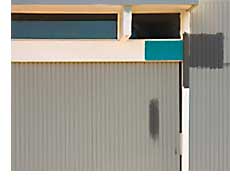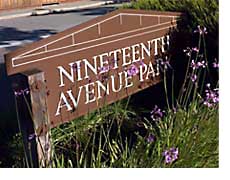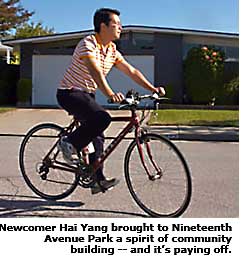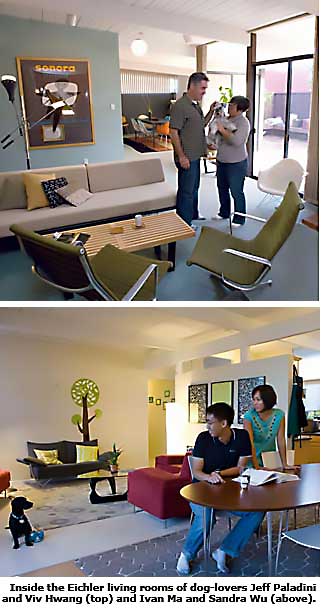Work in Progress: 19th Avenue - San Mateo
 By all accounts, the quiet Eichler enclave of Nineteenth Avenue Park has been a marvelous place to live since folks first arrived in 1955.
By all accounts, the quiet Eichler enclave of Nineteenth Avenue Park has been a marvelous place to live since folks first arrived in 1955.
"It was awesome," says Shannon Tallman, who grew up in the San Mateo neighborhood from age two, briefly left, but returned to raise three children there herself.
She remembers neighborhood baseball games and talent shows, with parents hauling pianos into their driveways to better entertain the community. "We had barbecues outside for no reason," says Rita Balliet, an original owner and Shannon's lifelong friend.

"There were patio parties and block parties," recalls Dorothy Ragent, who moved to Nineteenth Avenue Park with her husband Boris in 1956. "Kids would play out on the street till five or six in the evening."
And when there were threats, the neighborhood came together. Plans for a cement plant were quickly scotched, Dorothy Ragent remembers. "We took it upon ourselves to fight it," she says. "It helped that Roy Archibald"—San Mateo's popular mayor back then—"lived here."
Nor did the neighborhood ever turn surly. This is a place, after all, where longtime resident Dorothy Sussli welcomes newcomers and looks after her elderly neighbors, where car collector Joe Cuevas offers free advice to neighbors with car fetishes of their own, and where David and Linda Koehn, walking the neighborhood shortly after moving in, were invited inside by folks whose home they stopped to admire. "That was so kind," David says. "It was a real memorable moment for us."
Still, when Hai Yang, a young scientist who was born and raised in South China, moved to Nineteenth Avenue Park a year ago, he was surprised at the lack of spirit. "Not many people were enthusiastic about the community," he says.

The first 19th Avenue Park Neighborhood Association meeting he attended had folks from only a dozen families in attendance—in a neighborhood of almost 240 homes. "Sometimes," he says, "neighbors don't know their neighbors." He adds: "In China, people know their neighbors and they help each other."
Yang immediately set about building community—and his efforts are starting to pay off.
Nineteenth Avenue Park, built from 1953 to 1955 to designs by architects Jones ∓ Emmons, remains something of "a mixed bag," says Koehn, who also arrived last year.
Although many homes still show evidence of having gone through what neighbor Ken White calls "a period of ticky-tackiness," many others have recently been restored or revamped in keeping with the Eichler aesthetic.
Koehn's own home, a landmark because it is one of the first houses you see when entering from Charles Street, is being transformed from an eyesore to something hip, with replacement Eichler siding, an austere water-saving garden—and a two-story palm tree.

"There are a lot of homes I notice that are in the process," Koehn says. "If you see a lot of homes in process, that's a good sign."
But there's more to the Nineteenth Avenue Park story than the standard newcomers-restore-faded-neighborhood story. To start, the neighborhood is unusual among Eichler tracts in several ways.
It began partly as a blue-collar community, some old-timers say. Eichler neighborhoods tend to be professional and managerial. And from the start, Nineteenth Avenue Park had an unusually large percentage of Asian residents—during a time when few neighborhoods in the area would sell to Asians.
Also, Nineteenth Avenue Park gradually became one of the most urban of Eichler's neighborhoods, as large shopping centers and mid-rise office parks popped up along its fringe and as the three-lane Bayshore Freeway morphed into Highway 101 and Nineteenth Avenue was supplanted by Highway 92.
Today, the neighborhood is at the crossroads of the San Francisco Peninsula, with two crowded freeways intersecting blocks away, gleaming office towers serving as landmarks, and downtown San Mateo, vibrant and charming as ever, a 25-minute walk away. The Hayward Park Caltrain station, two blocks from the neighborhood, provides a commute alternative—as do bike paths. Hai Yang, a scientist for a pharmaceutical firm, bikes to work.
Yet, despite its central location, Nineteenth Avenue Park is a bit of a hidden Eichler enclave, less known, less esteemed, with homes less costly, than its siblings in Palo Alto or Sunnyvale, or even up the hill in San Mateo Highlands.




